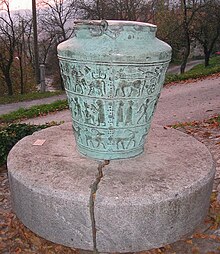Estonian culture

The Este culture is an Iron Age culture in the Po Valley (northern Italy ), which is named after a town-like settlement. Este, originally located on the Adige , which was built in the 5th century BC. Chr. Changed its course, was a center of metal processing . The settlement developed at the beginning of the 1st millennium BC. At the crossroads of important traffic routes. Essentially, only the cremation grave fields with rich additions remained.
In addition to the Villanova culture in the Bologna area and the Golasecca culture in the west of the Po Valley, it existed parallel to the Hallstatt period , influenced by the Urnfield culture . Este conveyed artistic and technical suggestions from the Hallstatt region to the south and Etruscan- Greek elements to the north. The figural metalwork by Este shows the implementation of southern suggestions. Este was the center of the so-called situle art . Characteristic are situles decorated with animals and ribbons with figure motifs. The most important example is the Benvenuti situla (600 BC). The development of sheet bronze work can be traced back to the end of the 4th century BC. Chr. Pursue. The Este culture survived the invasion of the Celts and only their successors, the Venetians , were absorbed in the Roman Empire .
The Este culture is ascribed to the forerunners of the Venetians (ital. Paleoveneti ). The Venetians formed a buffer between the Illyrians , whose tribal area lay in the Balkans behind Trieste , and the Celts in the Po Valley. They had their own language and culture that opened up to Greek influence but did not imitate Greek or Etruscan. The Venetians continued the tradition of the Este culture when it died out in Este. A modified figurative art lives on in Veneto to this day.
literature
- Glyn Daniel (Ed.): Encyclopedia of Archeology. Editor of the German edition Joachim Rehork . Nikol, Lübbe 1996, ISBN 3-930656-37-X .
Web links
- Situles in architecture and cultural history (PDF; 513 kB)
